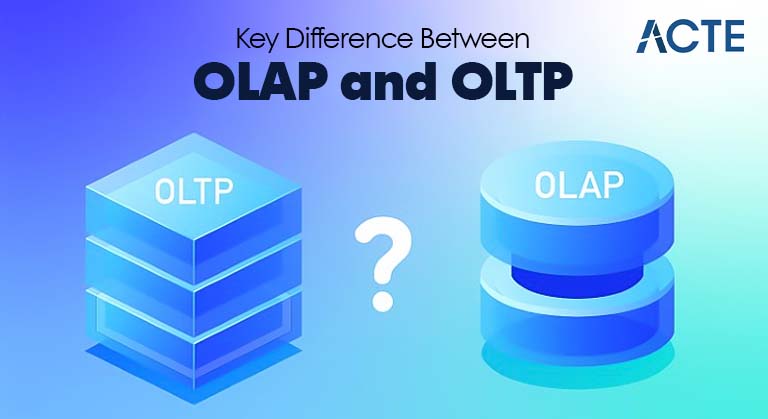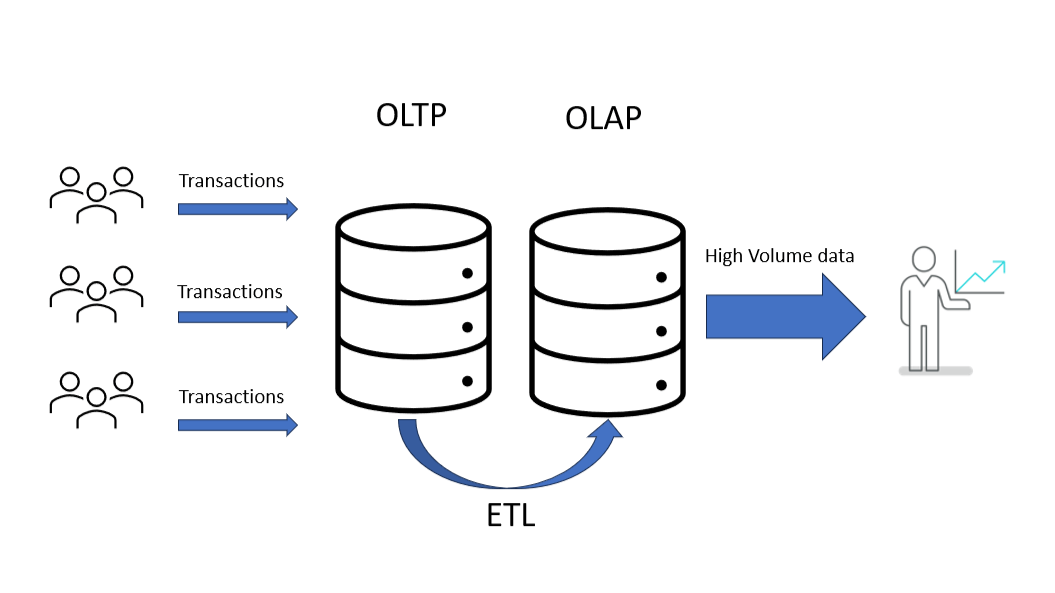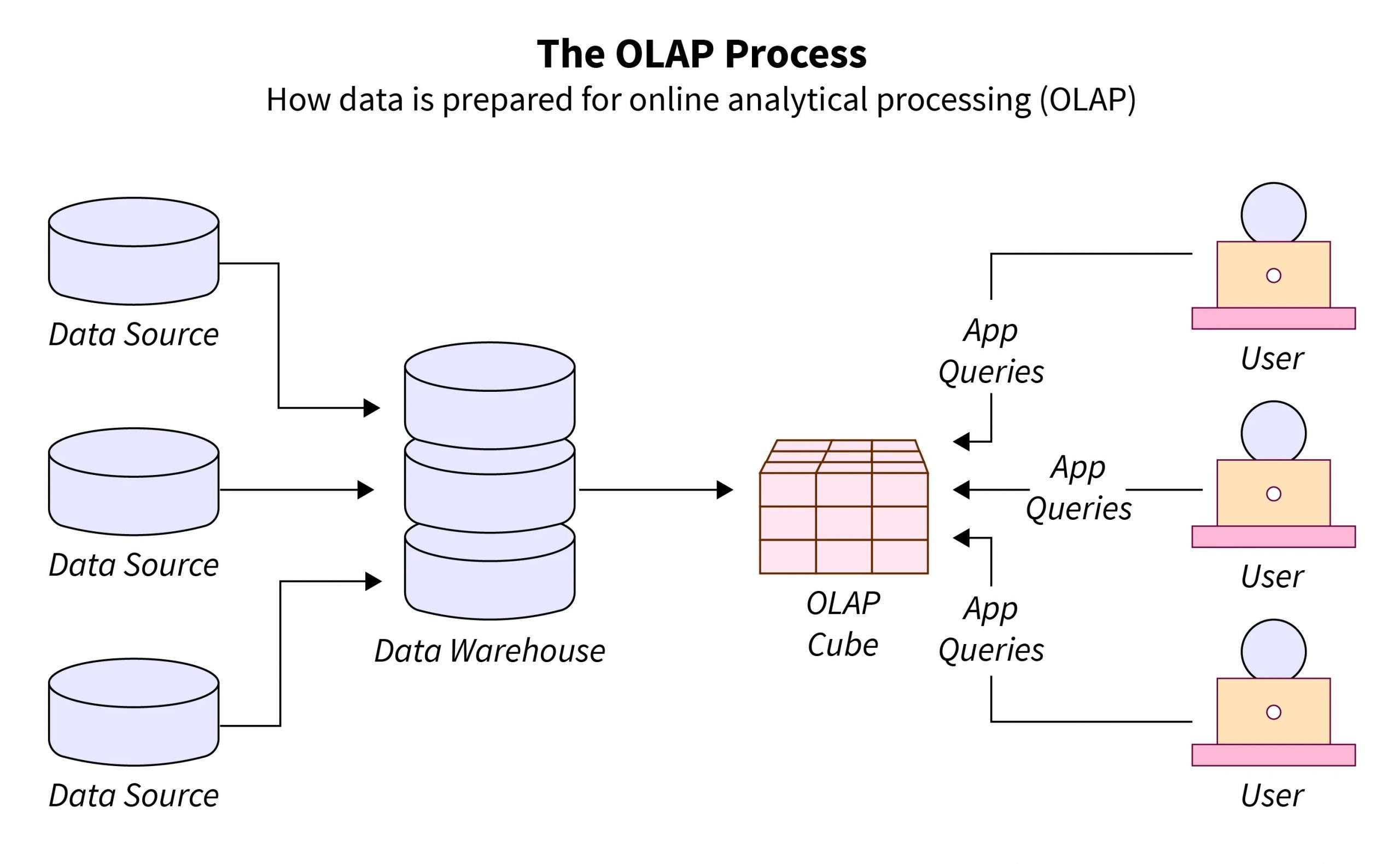
- Introduction
- What is OLAP?
- Key Features of OLAP
- What is OLTP?
- Key Features of OLTP
- Core Differences Between OLAP and OLTP
- Use Cases of OLAP and OLTP
- Benefits and Limitations
Introduction
Understanding the difference between OLAP and OLTP is essential for anyone working with data systems, as both play critical roles in business operations and decision-making. OLAP (Online Analytical Processing) is designed for complex queries and data analysis, typically involving large volumes of historical data to support decision-making, reporting, and business intelligence. In contrast, OLTP (Online Transaction Processing) focuses on real-time transactional tasks such as order entry, banking transactions, and retail sales, requiring high speed and accuracy. When you compare and contrast OLAP and OLTP, the key differences lie in their usage, data structure, and performance requirements OLAP systems are optimized for read-heavy operations and support multidimensional queries, while OLTP systems prioritize write-heavy, day-to-day operations with high concurrency. This distinction is especially important in the context of data mining OLAP and OLTP, as OLAP provides the aggregated, historical data necessary for discovering trends and patterns, whereas OLTP systems are less suitable for such analysis due to their real-time nature. Understanding these differences is crucial for professionals pursuing Database Training as it helps them design optimized systems tailored for either transactional efficiency or analytical depth. In essence, understanding the difference between OLAP and OLTP helps organizations choose the right system for their needs, ensuring efficient data management, faster insights, and improved overall performance across both analytical and operational environments.
Do You Want to Learn More About Database? Get Info From Our Database Online Training Today!
What is OLAP?
- Multidimensional Analysis: OLAP allows users to view data across multiple dimensions, such as time, geography, and product, making it easier to uncover patterns and trends that OLTP systems can’t efficiently handle.
- Optimized for Read-Heavy Workloads: While OLTP and OLAP databases serve different purposes, OLAP systems are designed to process large volumes of read-only queries, often aggregating data from various sources for analysis. Understanding these roles is crucial when learning what is Data Control Language in SQL, as managing permissions and access in both OLTP and OLAP environments is essential for maintaining data security and governance within complex database systems.
- Supports Data Warehousing: A data warehouse OLTP integration typically involves moving data from OLTP systems into OLAP systems for analytical processing, transforming real-time transactional data into strategic insights.
OLAP, or Online Analytical Processing, is a category of data processing that enables users to easily analyze multidimensional data from multiple perspectives. It is primarily used in business intelligence and data warehousing to support decision-making by providing fast responses to complex analytical queries. Unlike an OLTP database, which is optimized for handling real-time transactions, OLAP is structured for deep analysis and data exploration. Here’s a breakdown of its key characteristics:

- Advanced Querying and Reporting: OLAP tools support complex queries that involve large datasets, making them ideal for dashboards, forecasts, and decision-making tools.
- Less Emphasis on Normalization: Unlike OLTP systems, OLAP normalization is minimal to speed up querying and reduce complexity in data models.
- Scalability with Modern Databases: Some modern databases like ClickHouse OLTP are optimized for analytical workloads but also offer hybrid capabilities, blurring the traditional lines between OLTP and OLAP.
Key Features of OLAP
The key features of OLAP (Online Analytical Processing) make it a powerful tool for multidimensional data analysis and strategic decision-making. One of the most defining features of OLAP is its ability to handle complex queries quickly by aggregating large volumes of historical data from various sources. OLAP supports operations like slicing, dicing, drilling down, and pivoting, which enable users to analyze data from multiple angles with ease. It is primarily designed for read-heavy workloads, unlike OLTP systems that are optimized for real-time transactional tasks. This difference between OLAP and OLTP is crucial when building systems tailored for business intelligence versus operational efficiency. Gaining clarity on these concepts is especially valuable when referencing resources like a MongoDB Commands Cheat Sheet, as it helps database professionals understand how various commands apply differently in analytical versus transactional contexts, improving system design and query execution. When you compare and contrast OLAP and OLTP, OLAP systems provide insights into trends and patterns over time, while OLTP systems handle the everyday tasks like inserting, updating, or deleting data. OLAP is essential in data warehousing environments and plays a major role in business reporting and forecasting. It also supports data mining OLAP and OLTP by supplying the structured historical data needed for pattern recognition, clustering, and predictive analytics. In summary, OLAP’s ability to offer fast, flexible, and detailed analysis across massive datasets makes it an indispensable tool in today’s data-driven enterprises.
Would You Like to Know More About Database? Sign Up For Our Database Online Training Now!
What is OLTP?
- Real-Time Data Processing: OLTP systems are optimized for executing fast, short transactions like insert, update, and delete, making them ideal for applications that require instant response times.
- Highly Normalized Structure: Unlike OLAP systems, OLTP databases follow strict OLAP normalization rules to eliminate data redundancy and ensure consistency. Mastering these concepts through Database Training is essential for professionals aiming to design efficient, high-performance data systems that support real-time operations and maintain data integrity.
- Supports Day-to-Day Operations: The primary function of OLTP systems is to manage routine business operations. While OLTP and OLAP databases serve different needs, OLTP is focused on transactional efficiency.
OLTP, or Online Transaction Processing, refers to a class of systems designed to manage real-time transactional data efficiently. These systems are widely used in applications where high-speed data entry, processing, and retrieval are critical such as banking, e-commerce, and customer relationship management. An OLTP database is built to handle a large number of short online transactions while ensuring data integrity and speed. Here’s a closer look at its key characteristics:

- Data Warehouse Integration: A data warehouse OLTP connection involves extracting transactional data from OLTP systems into OLAP systems for long-term analysis.
- Concurrency and Reliability: OLTP systems support thousands of users simultaneously with strong data integrity controls and rollback capabilities.
- Modern Performance Enhancements: Technologies like ClickHouse OLTP are evolving to blend OLTP performance with analytical features, bridging the gap between transaction and analysis.
Key Features of OLTP
The key features of OLTP (Online Transaction Processing) systems revolve around high efficiency, speed, and reliability in handling day-to-day transactional data. An OLTP database is designed for real-time operations such as inserting, updating, and deleting data across various applications like banking, e-commerce, and inventory management. These systems are optimized for processing a large number of short transactions with minimal latency and maximum data accuracy. One of the defining characteristics of OLTP systems is their highly normalized database design, often referred to as OLAP normalization, which minimizes redundancy and maintains data consistency. This concept is also considered and Explore Top Buzzword In Database Management in SQL, highlighting the importance of efficient schema design in ensuring optimal performance and data integrity within transactional systems. When comparing OLTP and OLAP databases, OLTP systems focus on operational data processing while OLAP supports analytical and historical data analysis. OLTP ensures data integrity through features like ACID compliance and concurrency control, which are essential for managing simultaneous transactions from multiple users. As organizations scale, data from OLTP databases is often transferred to analytical platforms in a data warehouse OLTP setup for more extensive reporting and analysis. Furthermore, modern solutions like ClickHouse OLTP are beginning to offer hybrid capabilities that combine transactional speed with analytical power, blurring the traditional lines between OLTP and OLAP. These features make OLTP indispensable for businesses requiring fast, accurate, and secure transaction processing.
To Earn Your Database Certification, Gain Insights From Leading Blockchain Experts And Advance Your Career With ACTE’s Database Online Training Today!
Core Differences Between OLAP and OLTP
- Purpose: OLTP is designed for handling day-to-day transactions like sales and bookings, while OLAP is built for analytical tasks such as reporting and forecasting.
- Query Type: OLTP handles simple and fast queries that modify data (insert, update, delete), whereas OLAP manages complex queries that involve data aggregation and historical trends. Understanding this distinction is essential when learning SQL operations like the Replace in SQL instruction, which is more commonly used in OLTP environments to update records efficiently without disrupting transactional workflows.
- Data Structure: OLTP databases are highly normalized to maintain data integrity, while OLAP databases are often denormalized for quicker analysis and better performance.
- Speed and Performance: OLTP systems prioritize speed for writing data, while OLAP focuses on the speed of data retrieval and analysis.
- Usage in Data Mining: In data mining OLAP and OLTP, OLAP provides the historical and structured data needed for mining, whereas OLTP is not suitable due to its real-time nature.
- Compare and Contrast OLAP and OLTP: While OLTP supports operational tasks, OLAP supports decision-making making them complementary components in modern data architecture.
Understanding the difference between OLAP and OLTP is vital for designing efficient data systems tailored to specific business needs. OLAP (Online Analytical Processing) and OLTP (Online Transaction Processing) serve different purposes OLAP is used for data analysis, while OLTP is focused on real-time transaction processing. Here’s a breakdown of the core differences between OLAP and OLTP:
Use Cases of OLAP and OLTP
The use cases of OLAP and OLTP are distinct yet complementary, each serving critical functions within modern data-driven environments. An OLTP database is essential for real-time transactional systems such as online banking, e-commerce platforms, and airline reservation systems, where speed, accuracy, and data integrity are crucial. These systems are built with high OLAP normalization to ensure consistent and reliable data entry. In contrast, OLAP systems are used for data analysis, reporting, and business intelligence applications, where users need to explore historical data and uncover patterns. Mastering such analytical processes is vital when working with advanced SQL queries, including topics like understanding second highest salary in SQL, which often serve as foundational exercises in developing the complex query skills needed for OLAP environments. In many enterprises, data from OLTP systems is periodically transferred to OLAP systems through a data warehouse OLTP architecture, allowing for long-term storage and advanced analysis. Businesses often deploy OLTP and OLAP databases side-by-side to separate operational tasks from analytical processing, enhancing performance and clarity. Emerging technologies like ClickHouse OLTP are beginning to offer hybrid capabilities, enabling real-time analytics while maintaining fast transactional performance, bridging the gap between traditional OLTP and OLAP roles. These integrated use cases enable organizations to manage their daily operations while gaining strategic insights from historical trends, thereby supporting smarter decision-making across all levels of the business.
Preparing for a Database Job? Have a Look at Our Blog on Database Interview Questions and Answers To Ace Your Interview!
Benefits and Limitations
When evaluating the difference between OLAP and OLTP, it’s essential to understand the unique benefits and limitations of each system to make informed choices for specific business needs. OLTP systems offer high-speed processing, real-time updates, and data accuracy, making them ideal for transactional tasks like order entry, billing, and inventory management. Their ability to handle a massive number of concurrent transactions efficiently ensures smooth day-to-day operations. However, OLTP systems are limited when it comes to complex queries or large-scale data analysis. On the other hand, OLAP systems excel in multidimensional analysis, enabling users to identify trends, generate reports, and make strategic decisions based on historical data. Gaining a clear understanding of these systems through Database Training equips professionals with the skills needed to implement the right architecture for both transactional and analytical requirements. These systems are critical in data mining OLAP and OLTP contexts, where OLAP provides structured datasets necessary for uncovering patterns and insights. Despite their strengths, OLAP systems can struggle with real-time data updates and are often slower at handling write-heavy tasks. When you compare and contrast OLAP and OLTP, it becomes clear that each serves a specific purpose: OLTP is built for operational speed and reliability, while OLAP is optimized for analytical depth and decision support. Understanding these differences between OLAP and OLTP helps organizations deploy the right tools for both operational efficiency and strategic growth.


